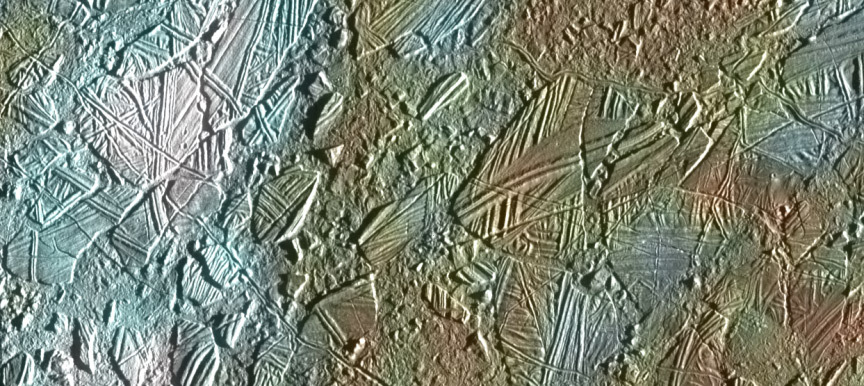News | December 16, 2005
Closest Europa Flyby Marks Start of Galileo Mission "Part II"

A small region of the thin, disrupted ice crust in the Conamara region of Jupiter's moon Europa shows the interplay of surface color with ice structures. Credit: NASA/Jet Propulsion Laboratory-Caltech
Published: Dec. 16, 1997
NASA's Galileo spacecraft today successfully made its closest-ever flyby of Jupiter's icy moon Europa, marking the start of an extended mission that will focus on new and tantalizing scientific questions raised by its just-completed, highly successful two-year primary mission.
"Galileo has earned a place in history as the first mission to orbit an outer planet," said Dr. Wesley T. Huntress, Jr., NASA's associate administrator for space science, Washington, DC. "Galileo already has returned a wealth of new information in its two-year scientific exploration of Jupiter's atmosphere and system of moons. But the best yet may still be ahead of us as Galileo continues its mission at Jupiter with a focus on the moons Europa and Io in the next two years."
Galileo dipped over Europa at an altitude of only 200 kilometers (124 miles), with the signal received on Earth at 4:49 a.m. PST. This was the first encounter of the Galileo Europa mission, which began formally on Dec. 8, just following the end of Galileo's primary mission. The Galileo Europa mission will study Jupiter's icy satellite in detail in hopes of shedding more light on the intriguing prospect that liquid oceans may lie under Europa's ice crust.
New images released today from Galileo's Europa encounter of Nov. 6 show more evidence that the moon has been subjected to intense geological deformation. The pictures show a mottled region of dark and splotchy terrain that scientists say represents some of the most recent geologic activity on Europa. It is believed the mottled appearance was created when chaotic areas of the bright, icy crust broke apart and exposed darker material underneath. The new images also show a smooth, gray band where the Europan crust has been fractured, separated, and filled in with material from the interior. Numerous isolated mountains or "massifs" are visible.
The new images represent a small portion of the 1,800 images obtained during Galileo's primary mission, including hundreds of high-resolution images of Jupiter's moons. The images and other information gathered by Galileo's science instruments have dramatically revised our knowledge of Jupiter and its moons, according to mission scientists.
The Galileo Europa mission is designed to follow up on these discoveries and will include eight consecutive Europa flybys through February 1999, followed by four Callisto flybys and one or two Io encounters in late 1999, provided the spacecraft remains healthy.
"The Galileo Europa mission really builds upon the success of the prime mission which has forced us to re-think many of our perceptions of the Jovian system," said Galileo project scientist Dr. Torrence Johnson. "We've acquired a tremendous pool of knowledge about Jupiter, its magnetosphere and its four largest moons."
The key findings of Galileo's primary mission include:
- The existence of a magnetic field on Jupiter's largest moon, Ganymede;
- The discovery of volcanic ice flows and melting or "rafting" of ice on the surface that supports the premise of liquid oceans underneath at some point in Europa's history;
- The observation of water vapor, lightning and aurora on Jupiter;
- The discovery of an atmosphere of hydrogen and carbon dioxide on the moon Callisto;
- The presence of metallic cores in Europa, Io and Ganymede and the lack of evidence of such a core in Callisto;
- Evidence of very hot volcanic activity on Io and observations of dramatic changes compared to previous observations and even during the period of Galileo's observations.
"We look forward to providing even more fascinating science results over the next two years," said newly appointed Galileo Europa mission project manager Bob Mitchell of NASA's Jet Propulsion Laboratory (JPL), Pasadena, CA.


